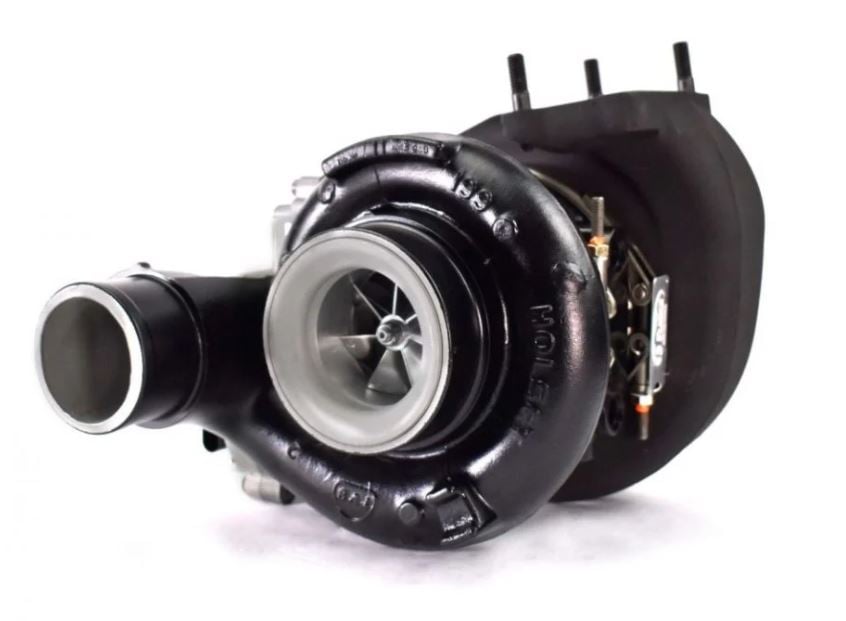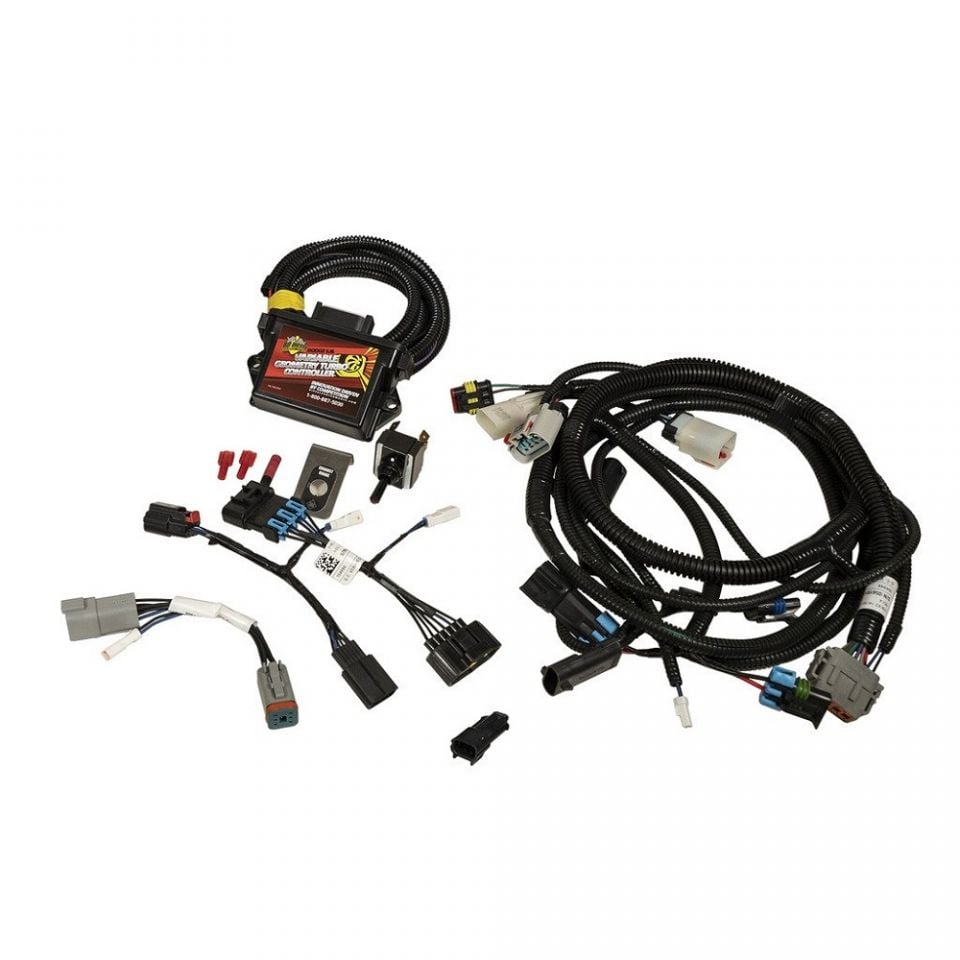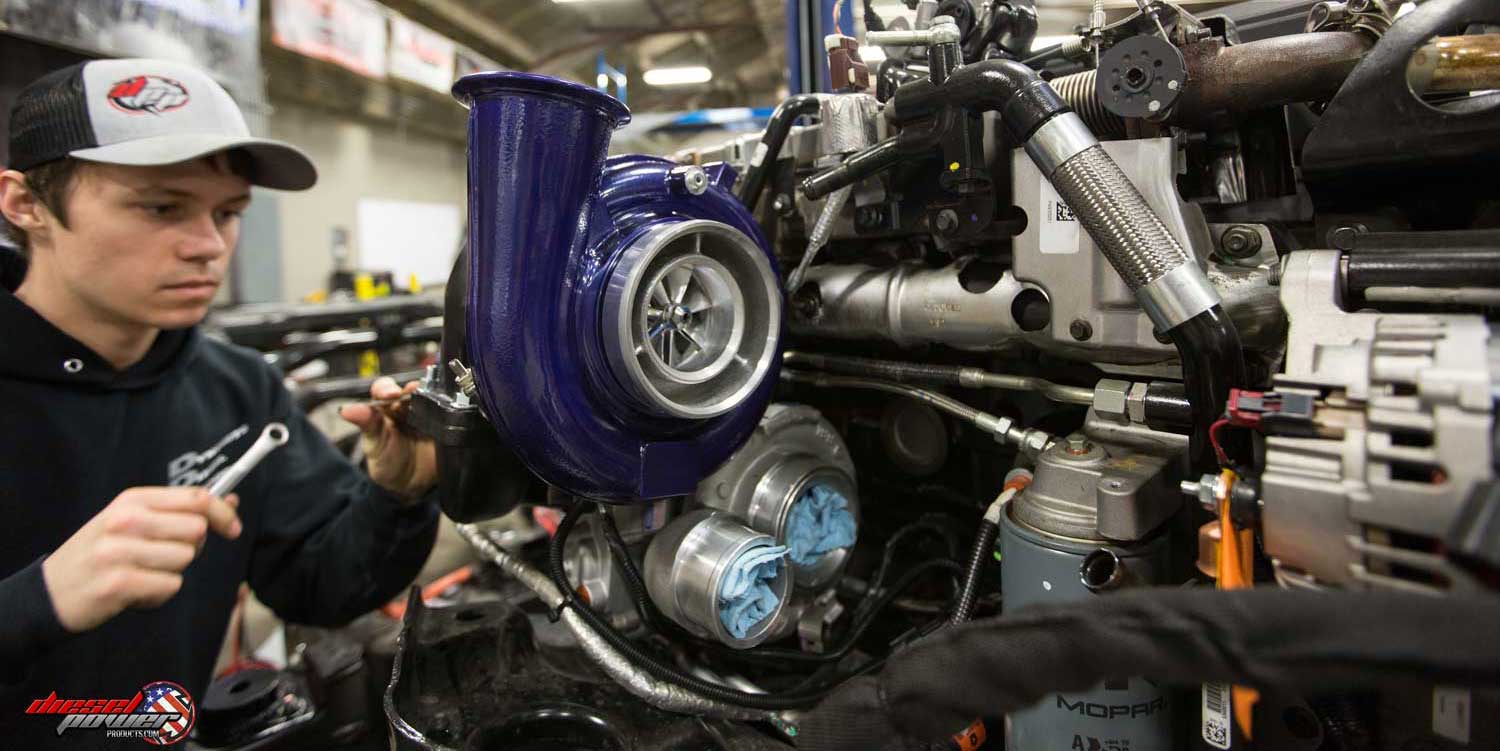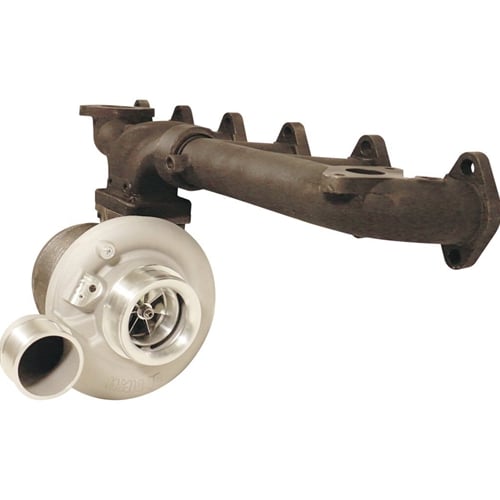If you’ve ever looked into upgrading the turbo on your late model diesel, you’ve likely noticed how many options there are. It can be a little difficult to choose which kind of turbo is best, so today we’re gonna take the mystery out of turbo selection and explain the pros and cons as well as the proper application of each type to hopefully make the decision a little easier. All turbos can be broken down into two major subsets: fixed vane or a variable geometry. For the last 15 years or so, diesel trucks have been coming from the factory with a Variable Geometry Turbocharger (VGT) and older trucks mostly came with a fixed vane charger, but to further complicate things, when picking an upgrade for your old or new pickup, both types are available for old and new rigs. Confused yet?
Fixed Vane Turbo:
Most “basic” turbochargers are considered a fixed vane, and while they are still used today in the gasoline world, on the diesel side of things they’re nonexistent. The trucks that came with a fixed vane or “traditional” turbocharger include the 1st, 2nd and 3rd gen Rams from 1989 to 2007, the 7.3 Powerstroke, and the LB7 Duramax. This is the simplest design of turbocharger, and it has three major parts: a turbine housing, compressor housing, and the shaft with a compressor on one end and turbine wheel on the other. Exhaust enters the turbine housing and is directed into the turbine wheel where it spins the shaft and the compressor on the other end, where fresh air is pumped into the engine. There are a few key dimensions used to classify all turbos, and usually the first is the diameter of the compressor inducer in millimeters. When someone asks “what size turbo does it have” this is the measurement they are after, and for a diesel pickup, usually its between 60 and 69mm for a stock to mildly modified engine.
The size of the turbine can be measured the same way, but the more important dimension of the exhaust side has to do with its flow. It’s expressed as an A/R ratio (area/radius) which is the relationship between the cross-sectional area of the exhaust pathway to the distance away from the centerline of the turbo. In general terms, the larger the A/R (.96, 1.10, 1.32) the more exhaust flow it will handle, but the tradeoff is less response and a slower spool up at lower RPM, and conversely the smaller the A/R ratio, the quicker the spool up will be, at the expense of more restriction at higher RPM. Every turbo has a sweet spot where it’s most efficient, and manufacturers try to size the turbo to spend most of its time at its peak efficiency. If this is done properly, the turbo will have a reasonably quick spool up time, good peak horsepower, and give enough airflow to keep EGT’s under control at peak load, like while towing.
There are many benefits to using a fixed vane turbocharger, and its best feature is how durable and reliable they are. Because there are no moving parts (other than the turbine/compressor) or electronics involved with its operation, there’s nothing that can really go wrong, and they will usually last well over 150,000 miles as long as they receive proper lubrication and air filtration. The engine is capable of producing more exhaust energy than the turbo needs to do its job, and if left unchecked, drive pressure can go up, EGTs will skyrocket, and the turbo will possibly spin too fast and lead to a failure, so to prevent that most fixed geometry turbos are used in conjunction with a wastegate. This is a simple valve in the exhaust stream before the turbine housing, and if the exhaust flow gets too high, the valve simply opens and allows the excess exhaust energy to bypass the turbine housing, which keeps the turbocharger under control and in its peak efficiency zone.
Because most aftermarket turbochargers use a fixed geometry design, there is a turbo out there to support any horsepower goal you have. The stock IHI turbo on an LB7 measures in at 60.5mm and can flow enough air to make about 530 horsepower before things start to get a little too hot. To safely make more power, you need more air, so a great option for a hot rodded LB7 would be the Fleece Cheetah. It’s a turbo kit that’s based around the factory IHI, but featuring a larger 63mm billet compressor wheel and a high flow inconel turbine wheel, it will easily support 625 rear wheel horsepower..
What is VGT:
In the mid 2000s, manufacturers started using a new turbo design which would further improve the drivability and response time of the diesel engine, and that was the variable geometry turbo. Ford’s first engine to use a VGT was the 6.0 Powerstroke, for GM it was the LLY Duramax, and for Ram it was the 6.7 Cummins. The compressor side of a VGT is unchanged from a fixed vane turbo, but the exhaust side is radically different. Inside the turbine housing are a series of teardrop shaped vanes that can be moved to direct the exhaust flow towards different parts of the turbine wheel to either speed it up or slow it down. Powerstroke and Duramax VGT’s use individual pivoting vanes activated by a rotating unison ring, and the Holset VGT found on a Cummins uses a sliding vane design where the vanes are all one assembly slid in and out along the center axis of the turbo. This way the turbo can provide higher airflow throughout a wider area of engine operation, which means more boost at lower RPM as well as less restriction at higher flow, or the vanes can completely close when off the throttle to help the engine warm up faster or act as an exhaust brake. To the driver, the VGT operation is seamless because its control system is integrated into the engine’s computer, and it uses information like throttle position, engine temperature, road speed, transmission gear and more to determine the best positioning of the vanes.
Sounds like the way to go, right? When they are working properly, a VGT has its upsides, but there are some downfalls as well which mean it may not be ideal for every application. Because of the complexity of the control and actuation systems, a VGT has a lot more parts that can fail. Sometimes the unison ring that moves the vanes can wear out or just get stuck from soot buildup, sensors can fail, or the actuator may wear out or stop working. When they do fail, you’ll immediately notice a loss in drivability since you’ve essentially lost either the lower or upper half of your turbo’s operating range. Also, since the exhaust has to flow in between some vanes to get to the turbine wheel, usually a Stock VGT will have greater exhaust back pressure on a performance application which can lead to excessive EGT. So, the question is, how much power can you make on a stock VGT?

Every turbocharger has its limit on how much power it can produce, and while stock sized VGTs are quick to respond to throttle input, usually once you are close to the mid 500hp mark, they’ll start to run out of breath. Naturally there are drop-in performance turbos available for a VGT truck just like with a fixed vane, and whether you have a Powerstroke, Duramax, or a 6.7 Cummins, Fleece Performance has a Cheetah turbo for you. They are designed to bolt directly into the stock location, but they flow considerably more air both on the compressor and turbine side. Careful machining is required and often the vanes themselves are made thicker to allow more flow between them, but once the larger wheels are combined with a modified housing, you have a turbo that spools up like stock, and can support a lot more horsepower. The 63mm Cheetah for the LML Duramax has the same exact footprint as the stock turbo so all the piping, actuators, sensors, and oil lines connect up, but the cheetah can support 650hp and safely makes up to 40 pounds of boost, all while spooling up quicker than stock and offering a broader torque curve.
Turbo Conversion
Both turbo designs have their pros and cons, and if you’re dissatisfied with the performance of either style, you can easily convert to the other with some help from the aftermarket. Probably the most common swap is to remove a VGT and switch to a fixed vane turbo. Usually, owners who do this are fed up with the high failure rate of a stock VGT, want a more reliable design, or just want less restriction in the exhaust for a higher horsepower build.
If you have a 2008+ 6.7 Cummins and you want to ditch the VGT, you have two choices: a stock position manifold or a 2nd gen swap. A BD Diesel Iron Horn Turbo Kit will allow you to install a fixed vane S300 T4 turbo onto your 6.7 Cummins in the stock location, low and toward the rear of the engine. The kit comes with a T4 exhaust manifold, the turbo itself, and of course the mounting hardware and gaskets, but that’s all you’ll need to install the turbo. It will work with your existing cold air intake, down pipe, and charge air cooler tubes, and the exhaust manifold will even bolt up to your EGR System. Of course, you’ll need to have the truck tuned to get rid of the check engine light caused by the missing VGT sensors and actuator, but other than that, it’s a drop-in solution. The kit is available with several different turbo sizes, but for daily driving and moderate towing most owners will select the S363 (63mm) option for its quick spool up and 550hp capability.
If you have an itch for even more horsepower from your 6.7 Cummins, you will need a larger turbo than you can physically fit in the stock location. A great solution is a 2nd gen swap, which is based around an exhaust manifold originally designed for a 1998.5 to 2002 Cummins, where the turbo is mounted both higher and further forward on the engine. Fleece Performance has one of the most complete 2nd gen swap kits on the market, and the extra space afforded by the manifold allows you to install a much larger S400 turbocharger. The 2nd gen manifold is a divided design which evens out exhaust distribution between the back and front of the engine which reduces spool up time and lowers EGT. You can get the Fleece 2nd gen swap kit with an S463 or S467 (63 and 67mm), and because of the new location of the turbo, the kit also comes with all necessary hoses and fittings along with a new 4” down pipe, 5” air intake, and charge pipe to connect to the intercooler. With supporting fuel modifications, the S467 can support about 800whp.
The one obvious thing you’ll lose by giving up your VGT is the ultra-wide powerband, but that’s not a huge deal as long as you pick the properly sized turbo for your setup, but if you tow frequently, the biggest thing missing is the exhaust brake functionality. Luckily, PacBrake developed one of their PRXB exhaust brakes specifically for 6.7 Cummins running a fixed vane turbo.
Fixed Vane to VGT:
So far, it seems like a fixed vane turbo with an external exhaust brake might be the ideal setup for everyone, but there are situations where a VGT can actually be beneficial on a truck that never came with one, like a 2003 to 2007 Ram 5.9 Cummins that spends a lot of time towing HEAVY trailers. While removing a factory VGT from a newer truck is no problem, adding a VGT to an older truck that never had the electronics to operate it is a whole new challenge, but luckily BD Diesel has just the solution with their Howler Stock VGT Turbo Kit.
This allows you to use a factory HE351VE VGT from a 2008 and newer 6.7 Cummins on your older 5.9 common rail. Instantly you gain faster spool up than the stock turbo, but it also supports more top end horsepower as well. Physically mounting the turbo is taken care of with the included exhaust manifold and adapters for plumbing the oil and coolant lines, but the real trick is the electronics that control the vanes. BD Diesel has developed a control module and wiring harness that intercepts signals like throttle position, coolant temp, and boost, and it actuates the vanes in the same way they would on a factory 6.7 application. You also get a switch to install in the dashboard to engage the exhaust brake, and it even has a speed sensor built in so the controller can adjust the vanes to optimize turbo speed.

So, Which Option Belongs On Your Truck?
This is probably the most difficult question to answer because there are so many great options to choose from, and the best turbo depends on your modifications, how you use the truck, and even personal preference, so we’ll end with some guidelines that will help you make the right decision for you.
- Be realistic with your horsepower goals: As much as we’d like to make 750hp, it takes a lot of money to get there, so don’t just buy the biggest turbo hoping you might throw in some larger injectors and a built transmission a year from now. When it comes to turbos bigger isn’t always better, and a too large turbo will be miserable to drive. If you have a 500hp truck, get a turbo sized appropriately, usually around 60 to 63mm. Conversely, if you are making 800 horsepower, don’t try to install a tiny turbo hoping for quicker spool ups, it will be a restriction and cause excessive EGT.
- VGT or Fixed Vane: While a stock VGT turbo can have reliability issues, it does provide a lot of benefits like the broad torque curve and the exhaust brake which make it an attractive option for a work truck or a lightly modified street truck. A drop-in VGT like a Cheetah is much simpler to install than a conversion, and it can support lots of power as well.
- How you use the truck: do you tow 18,000lbs once a week or do you hit the drag strip instead? For all-out performance applications, a larger fixed geometry turbo like an S467 is usually ideal, and for major towing duties, a smaller VGT might get a slight nod, but there is an exception to every rule. If you have a mixed-use work/play truck, you’ll have to be the judge.




One thought on “VGT vs Fixed Vane Turbo Swap: Is There a Clear-Cut Winner?”